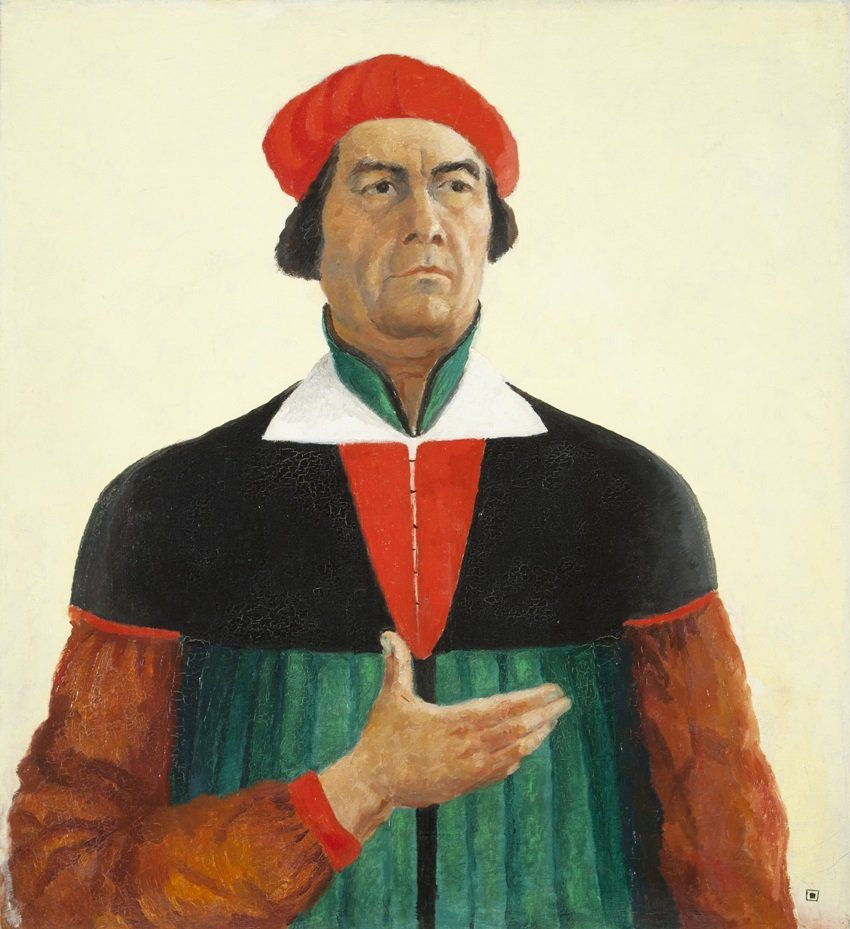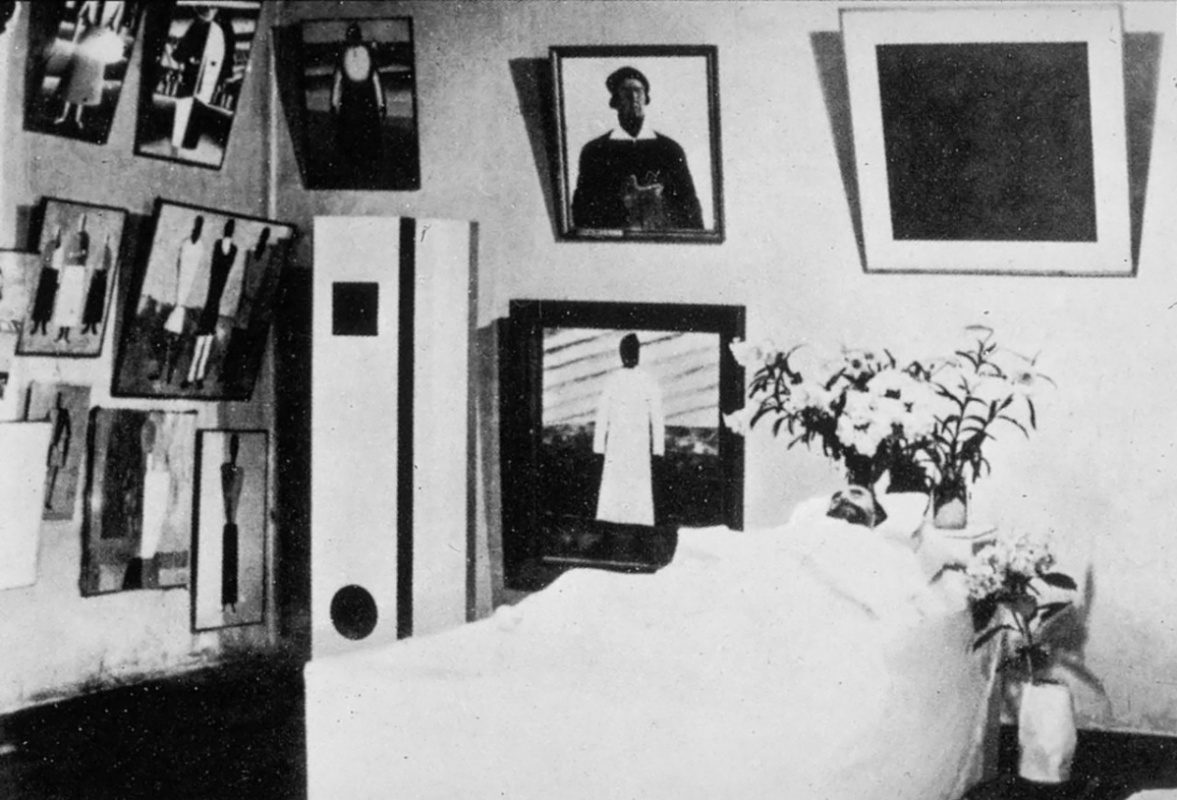log in
Enter site
Login to use Arthive functionality to the maximum
Self-portrait
Kazimir Malevich • 绘画, 1933, 73×66 厘米
画作描述 «Self-portrait»
Among hundreds of works by Kazimir Malevich one cannot find so many self-portraits. Most of them were painted at the dawn of his artistic career when he boldly experimented with styles to find his own creative way. Malevich painted his first self-portrait in 1907 as one of his "fresco" series on religious subjects. There was no trace left of this similarity with icons in three self-portraits that followed: the artist discovered Post-Impressionism and Fovism, and it was time for the experiments with color and form. Famous self-portrait of Malevich from the Tretyakov gallery was painted in 1910 - it symbolizes the transition of the artist to completely new artistic principles. Here comes demonically glowing red outlines of female bodies to replace the sexless figures of the saints in the background, and Malevich himself looks pretty freaky.
A few years later, the year of the famous "Black square" creation, the founder of Suprematism painted another work, which would be extremely difficult to call a self-portrait, if not the title. But in the last years of his life Malevich suddenly departed from the rigor of his geometric Suprematist works and began to paint neo-classical portraits. The year of 1933 was difficult for the artist: from the inside he had been gradually destroyed by the deadly disease, and from the outside he was pressed by the ubiquitous socialist realism, which became almost the only approved style of painting in the Soviet Union. Only with his paintings could Malevich prove everyone around and himself that he did not give up and was still able to work. He painted another self-portrait, not like any of the previous. Some experts compare this work to a famous self-portrait by Albrecht Dürer (1500). Malevich depicts himself in the costume of the Doge of Venice on neutral "Suprematist" background without overloading the picture with unnecessary images and focusing only on his own figure. Kazimir Severinovich never listed modesty among his virtues and he puts himself on a par with the masters of the Renaissance with this summary portrait. He even reproduced the effect of fresco painting on the canvas.
Numerous researchers at different times various riddles and hidden messages Malevich`s “Self-portrait” of 1933. The most obvious of them is the image of a tiny black square in the lower right corner of the canvas, where artists usually inscribe their names (Malevich repeatedly signed his late realistic works this way). Much controversy was aroused by the artist`s strange gesture, but in the end most critics agreed on the opinion that Malevich holds the invisible "black square" in his hand, thus expressing the hope that sooner or later his work will be recognized and understood by future generations. With the same gesture, the Mother of God points to the Baby on Odigitria - icons depicting the Virgin Mary with Jesus. Odigitria means “pointing the way” in Greek. Malevich thinks of himself as the one who pointed out a new path to art, and his Black Square, divine child. This is not speculation: in 1915, Malevich called his square the "royal baby." Painted in a realistic manner, this self-portrait becomes the apotheosis of the non-objective proclaimed by Malevich: there is no "Black square", it is just the right angle of the thumb and the palm, where Malevich`s royal baby would fit.
This self-portrait became a kind of Manifesto by Malevich, the proclamation of his invincibility and freedom. It was exactly this painting that his followers and disciples hung at the head of his Suprematist coffin next to the "Black square".
Written by Eugenia Sydelnykova
A few years later, the year of the famous "Black square" creation, the founder of Suprematism painted another work, which would be extremely difficult to call a self-portrait, if not the title. But in the last years of his life Malevich suddenly departed from the rigor of his geometric Suprematist works and began to paint neo-classical portraits. The year of 1933 was difficult for the artist: from the inside he had been gradually destroyed by the deadly disease, and from the outside he was pressed by the ubiquitous socialist realism, which became almost the only approved style of painting in the Soviet Union. Only with his paintings could Malevich prove everyone around and himself that he did not give up and was still able to work. He painted another self-portrait, not like any of the previous. Some experts compare this work to a famous self-portrait by Albrecht Dürer (1500). Malevich depicts himself in the costume of the Doge of Venice on neutral "Suprematist" background without overloading the picture with unnecessary images and focusing only on his own figure. Kazimir Severinovich never listed modesty among his virtues and he puts himself on a par with the masters of the Renaissance with this summary portrait. He even reproduced the effect of fresco painting on the canvas.
Numerous researchers at different times various riddles and hidden messages Malevich`s “Self-portrait” of 1933. The most obvious of them is the image of a tiny black square in the lower right corner of the canvas, where artists usually inscribe their names (Malevich repeatedly signed his late realistic works this way). Much controversy was aroused by the artist`s strange gesture, but in the end most critics agreed on the opinion that Malevich holds the invisible "black square" in his hand, thus expressing the hope that sooner or later his work will be recognized and understood by future generations. With the same gesture, the Mother of God points to the Baby on Odigitria - icons depicting the Virgin Mary with Jesus. Odigitria means “pointing the way” in Greek. Malevich thinks of himself as the one who pointed out a new path to art, and his Black Square, divine child. This is not speculation: in 1915, Malevich called his square the "royal baby." Painted in a realistic manner, this self-portrait becomes the apotheosis of the non-objective proclaimed by Malevich: there is no "Black square", it is just the right angle of the thumb and the palm, where Malevich`s royal baby would fit.
This self-portrait became a kind of Manifesto by Malevich, the proclamation of his invincibility and freedom. It was exactly this painting that his followers and disciples hung at the head of his Suprematist coffin next to the "Black square".
Written by Eugenia Sydelnykova



